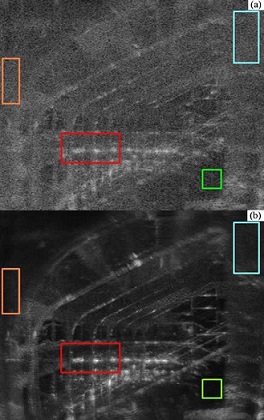Speckle
Figure: Concealed Knife. (a) Image
of a knife under a thin brown robe at 632
GHz. (c) Co-added image of a knife taken
at 16 independent angles. The quantitat-
ive traces below each image show the sig-
nal along the blue line in each image. Th-
ese graphs show that the speckle contrast
noise is reduced by (16)1/2=4 by the ave-
raging over the 16 independent images.
Use of active illumination comes at a price, speckle and other coherent effects [1]. These can severely degrade image quality, interpretation, and recognition. The lower panel of Figure: Indoor Image make link to previous page shows an active image of a head [5]. which can be compared with the passive image in the upper panel. This active image shows the dominance of specular reflections (the bridge of the forehead and parts of the cheeks) that are perpendicular to the imaging axis), the lack of signals from non-optimally oriented specular features (the rest of the skin of the face), and the dominance of speckle in the beard.
Modulated Mode Mixing to Mitigate both Speckle and Requirements for "special" target orientation:
An avenue of attack on the problems of active imaging (speckle from diffuse targets and the requirement for strategic orientation for specular targets) is provided by the very high brightness temperature of modest illuminator power confined in a narrow bandwidth.
If it is possible not only to illuminate this extended image from many modes/angles and mix the illumination on the time scale of the pixel dwell time, the speckle contrast ratio will be reduced by a factor of $N^{1/2}$, where $N$ is the number of modes participating in the illumination.
This effect can first be seen by first considering a simple image, a knife covered by a cloth, with the diffuse reflection from the cloth providing a speckle pattern that overlays the image of the knife. Figure: Concealed Knife shows this reduction in coherent speckle that results from its illumination from 16 independent modes.
The atrium of the Physics Department at Ohio State, shown in Figure: Physics Building Atrium , represents a larger (size scale of 50 m) and much more complex image. Even with its ~ 108 modes at 217 GHz, the brightness temperature per mode of the atrium illuminated with a 5 W EIK illuminator is still of the order 1010 K [7].
Figure: Physics Building Atrium GHz Image shows its image at 217.8 GHz with and without mode mixing. There is a more detailed discussion of these results below, including quantitative analyses of the speckle statistics within the several colored boxes in these images.

Figure: Physics Building Atrium. Optical image of the atrium of the |

Figure: Physics Building Atrium GHz |
References
- Millimeter-Wave and Submillimeter-Wave Imaging for Security and Surveillance Proc. IEEE 95, 1683-1690 (2007). Google Scholar
- Dependence of image speckle contrast on surface roughness Opt. Commun. 14, 324-327 (1975). Google Scholar
- Some fundamental properties of speckle J. Opt. Soc. Am. 66, 1145-1150 (1976). Google Scholar
- Speckle Phenomena in Optics: Theory and Applications (Roberts and Company, 2007). Google Scholar
- Multimode illumination in the terahertz for elimination of target orientation requirements and minimization of coherent effects in active imaging systems Opt. Eng. (Bellingham, WA, U. S.) 51, 091604-1,7 (2012). Google Scholar
- Elimination of Speckle and Target Orientation Requirements in Millimeter-wave Active Imaging by Modulated Multimode Mixing Illumination J. Opt. Soc. Am. A 29, 2643-2656 (2012). Google Scholar